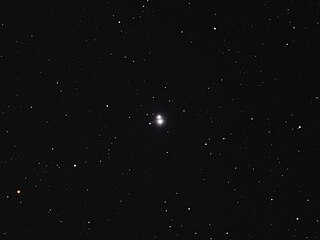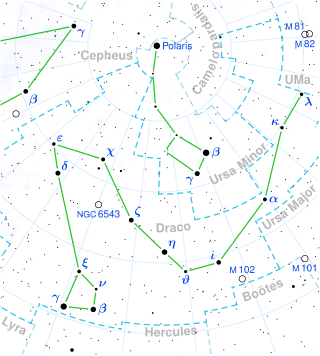Rho Tucanae is a binary star system in the southern constellation of Tucana. It is visible to the naked eye with a combined apparent visual magnitude of +5.38. Based upon an annual parallax shift of 24.37 mas as seen from Earth, it is located 131 light years from the Sun.

Pi Virginis is a binary star in the zodiac constellation of Virgo. It is visible to the naked eye with an apparent visual magnitude of 4.64. The distance to this star, based upon parallax measurements, is roughly 380 light years.

Nu Aurigae, Latinised from ν Aurigae, is the Bayer designation for a star in the northern constellation of Auriga. It is visible to the naked eye with an apparent visual magnitude of 3.96 and is approximately 220 light-years distant from the Earth. This is an evolved giant star with a stellar classification of G9.5 III. It is a red clump star, which indicates that it is generating energy through the fusion of helium at its core. The outer envelope has expanded to 19 times the radius of the Sun and cooled to 4,571 K, giving it the characteristic yellow-hued glow of a G-type star. It shines with 135 times the luminosity of the Sun.
39 Boötis is a triple star system located around 224 light years away from the Sun in the northern constellation of Boötes. It is visible to the naked eye as a faint, yellow-white hued star with a combined apparent magnitude of 5.68. The system is moving closer to the Earth with a heliocentric radial velocity of −31 km/s.

Iota Canis Majoris, Latinized from ι Canis Majoris, is a solitary variable supergiant star in the southern constellation of Canis Major. It is visible to the naked eye with an apparent visual magnitude that varies between +4.36 and +4.40. The distance to this star is approximately 3,100 light years based on parallax measurements. It is drifting further away with a radial velocity of +41.2 km/s.

Psi¹ Draconis, also designated 31 Draconis, is a triple star system in the northern constellation of Draco. The system is fairly close, and is located about 75 light-years from the Sun, based on its parallax.
Pi2 Cygni, Latinized from π2 Cygni, is a triple star system in the northern constellation of Cygnus. It is visible to the naked eye about 2.5° east-northeast of the open cluster M39, having an apparent visual magnitude of 4.24. Based upon an annual parallax shift of 2.95 mas, it is located at a distance of roughly 1,100 light years from the Sun.

Theta Draconis, a name Latinized from θ Draconis, is a binary star system in the northern circumpolar constellation of Draco. It is faintly visible to the naked eye at night with an apparent visual magnitude of 4.12. Parallax measurements place it at an estimated distance of 68.6 light-years from the Sun, and it is drifting closer with a radial velocity of −8 km/s. It has a relatively high proper motion, traversing the celestial sphere at the rate of 0.464″ per year. O. J. Eggen included this star as a member of the NGC 1901 supercluster based on its space motion.
Sigma Ceti is the Bayer designation for a star in the equatorial constellation of Cetus. With an apparent visual magnitude of 4.78, it can be seen with the naked eye on a dark night. Based upon an annual parallax shift of 37.46 mas, it lies at an estimated distance of 87.1 light years from the Sun. It is a probable astrometric binary star system.
Omega Draconis, Latinized from ω Draconis and also known as 28 Draconis, is a binary star in the constellation of Draco. The system is fairly close, and is located about 76 light-years away, based on its parallax.
39 Draconis is a wide binary star system in the northern circumpolar constellation of Draco. It has the Bayer designation b Draconis, while 39 Draconis is the Flamsteed designation. This system is visible to the naked eye as a dim, white-hued point of light with an apparent visual magnitude of 5.0. Parallax measurements made by the Hipparcos spacecraft put it at a distance of 184 light-years, or 56 parsecs away from the Sun. The system is moving closer to the Earth with a heliocentric radial velocity of -24.5 km/s.
Zeta Eridani is a binary star in the constellation of Eridanus. With an apparent visual magnitude of 4.80, it is visible to the naked eye on a clear dark night. Based on parallax measurements taken during the Hipparcos mission, it is approximately 110 light-years from the Sun.

Sigma Geminorum is a binary star system in the constellation Gemini, just to the northeast of Pollux. It is visible to the naked eye with an apparent visual magnitude of 4.20. Its annual parallax shift of 26.08 mas indicates that it is located 125 light years from the Sun.
Chi Geminorum is a binary star system in the constellation Gemini, near the western border with Cancer. It can be viewed with the naked eye on a dark night, having an apparent visual magnitude of 4.98. Based upon an annual parallax shift of 12.73 mas, it is located roughly 260 light years from the Sun.

Sigma Herculis, Latinized from σ Her, is a binary star system in the northern constellation of Hercules. It has a combined apparent visual magnitude of 4.18, making it bright enough to be visible to the naked eye. Based upon an annual parallax shift of 10.36 mas as seen from Earth, Sigma Herculis is located about 310 light years away from the Sun.
47 Ophiuchi is a binary star in the constellation Serpens. The combined apparent magnitude of the system is 4.54. The system is located about 98.1 light-years, or 30.1 parsecs away, based on its parallax as measured by Hipparcos.
20 Persei is a visual binary star in the northern constellation of Perseus, a few degrees from Pi Persei. It is visible to the naked eye as a dim, yellow-white hued point of light with a combined apparent visual magnitude of 5.343. The system is located around 230 light-years (71 pc) away from the Sun, based on its parallax. It is receding from the Earth with a heliocentric radial velocity of +6 km/s.
ω Leonis, is a star system located in the zodiac constellation of Leo. It is visible to the naked eye in the absence of light pollution, with an apparent visual magnitude of about 5.4. The distance to this star, as determined using parallax measurements, is around 108 light years from the Sun. Because of its location close to the ecliptic, it is subject to being obscured by the Moon, and potentially by planets.
Rho1 Eridani , is a star located in the constellation Eridanus. It forms an asterism with the stars Rho2 and Rho3 Eridani, south of Cetus, in the upper north east portion of Eridanus. The star has an apparent visual magnitude of 5.75, which indicates it is faintly visible to the naked eye on a clear, dark night. Based upon parallax measurements made with the Hipparcos satellite, this star is roughly 320 light years away from the Sun. Judging from changes to its proper motion, there is a chance that this is an astrometric binary.
Lambda Crateris, Latinized from λ Crateris, is the Bayer designation for a suspected binary star system in the southern constellation of Crater. With an annual parallax shift of 23.32 milliarcsecond as observed from Earth, it is located around 140 light years from the Sun. It is faintly visible to the naked eye with an apparent visual magnitude of 5.08.







